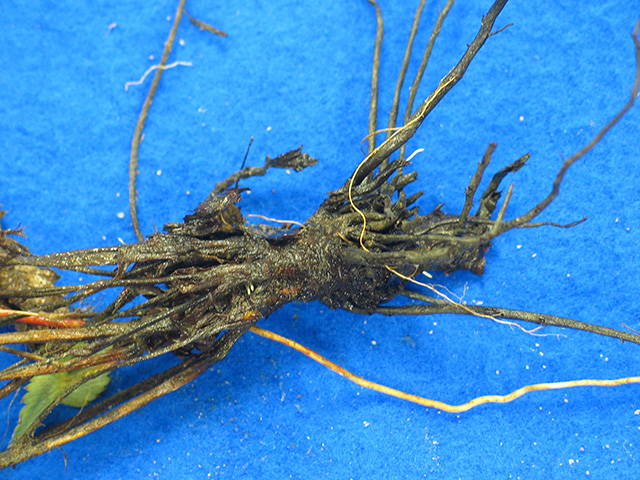Managing root rots can be essential for successful production of strawberry in the northeastern U.S. Prevention is key, with focus on cultural practices at planting. There are no conventional fungicides for black root rot.
As the name suggests, roots on plants affected by black root rot turn dark black. Before a root is completely black, individual dark lesions (spots) can be evident, which is in contrast with red stele. Eventually all roots become black. The center of roots often remains white (first image below) in contrast with red stele. Dead roots commonly have a “rat tail” appearance.
The cause of black root rot is complex. It is not caused by a single pathogen, but rather its occurrence has been associated with several pathogens (various fungi and the lesion nematode) as well as environmental conditions. The causal pathogens are thought to build up with successive crops. Environmental and other stress factors that have been associated with black root rot occurrence include herbicide injury, winter or cold injury, and excessive soil moisture.
There are no resistant varieties, but some, notably Honeoye and Jewel, are especially susceptible. Select a field with good draining soils (avoid heavy, wet soils), where root rots have not occurred in previous strawberry crops and where strawberries have not been grown for 2-3 years. Increase soil tilth by incorporating organic matter such as compost and cover crops. Purchase certified plants from a reputable nursery. Before planting, inspect plants to ensure the root system is a healthy white color. Plant on raised beds. Minimize soil compaction. Subsoil and use other practices to improve drainage. Minimize the opportunity for pathogens to be moved to new plantings from contaminated fields in soil on equipment, boots, or in water runoff. Inspect plants routinely after planting. When dying plants are found, determine the cause and remove the plants if the cause is a root rot.
The biofungicides Actinovate and Double Nickel can be applied to soil at planting and through drip to manage black root rot in commercial crops. They are approved for organic production. Pre-plant soil fumigation can be effective for black root rot, but has been inconsistent.
Please Note: The specific directions on pesticide labels must be adhered to — they supersede these recommendations if there is a conflict. Any reference to commercial products, trade or brand names is for information only; no endorsement is intended. For up-to-date information on labeled fungicides see Cornell Pest Management Guidelines for Berry Crops.
Updated April 2017.




